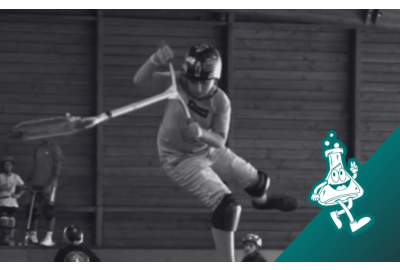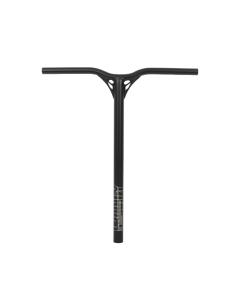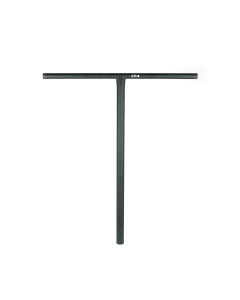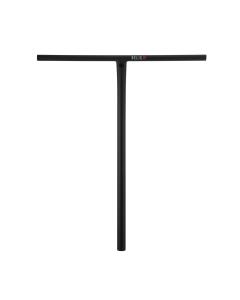The handlebar is more than just a stunt scooter part — it’s a key component that impacts your comfort, defines your style, and affects your performance. Whether you ride in skateparks or prefer the street, here’s a simple and clear guide to help you choose the handlebar that suits your needs.
1. Material : lightness and strength
For your stunt scooter handlebar, you can choose between three different materials. The main differences lie in weight and strength. Your riding style and level also matter when choosing the perfect handlebar !
- Steel : Strong, durable and rather heavy — the choice of street riders because it can handle the hardest impacts. Be aware, its weight (over 1 kg) makes it less maneuverable.
- Aluminum : Light and easy to handle — perfect for skatepark tricks. However, it’s slightly less resistant to impacts (under 1 kg).
- Titanium : The perfect balance between aluminum and steel — light, strong, durable... but also more expensive (under 1 kg).
2. Shape : T-Bar or Y-Bar ?
There are two common handlebar shapes in stunt scooters : the T-Bar and the Y-Bar (also known as V-Bar). Choose the shape you like best — the only rule is to go with what suits your style and preferences !
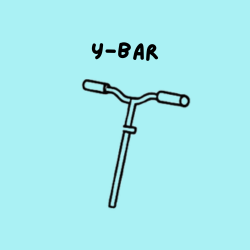

Different due to its Y-shape, the main distinction is that it sometimes features a backsweep (a slight backward angle), which makes tricks like barspins easier.
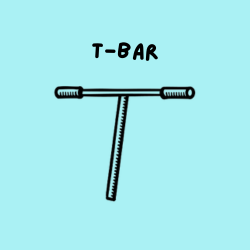

Pure simplicity — often favored by street riders for its strength and minimalist look.
3. Dimensions : height and width — it’s all about balance
The height and width of your handlebar depend on several factors :
-
Your height
-
Your body type
-
Your style of stunt scooter riding
About height :
Ideally, your handlebar should come up between your belly button and your hips.
- Street : Go for a taller handlebar for more stability.
- Skatepark : Choose a lower handlebar — perfect for rotations and quick tricks.
Refer to these tables if you're unsure about which handlebar height to choose :
For Skatepark use :
| Rider’s height | Handlebar height | Recommended age |
|---|---|---|
|
115 - 124 cm |
390 - 500 mm
|
8 - 10 years |
|
125 - 144 cm |
450 - 530 mm | 10 - 12 years |
|
145 - 162 cm |
510 - 600 mm | 12 - 15 years |
|
163 - 175 cm |
600 - 660 mm | 15 - 18 years |
|
> 175 cm |
> 600 mm | +18 years |
For Street use :
| Rider’s height | Handlebar height | Recommended age |
|
115 - 124 cm |
490 - 550 mm
|
8 - 10 years |
|
125 - 144 cm |
550 - 610 mm | 10 - 12 years |
|
145 - 162 cm |
610 - 700 mm | 12 - 15 years |
|
163 - 175 cm |
700 - 760 mm | 15 - 18 years |
|
> 175 cm |
> 760 mm | +18 years |
Looking for a middle ground ? Go for a versatile setup :
| Recommended age | Handlebar height | Recommended age |
|
115 - 124 cm |
440 - 530 mm
|
8 - 10 years |
|
125 - 144 cm |
510 - 560 mm | 10 - 12 years |
|
145 - 162 cm |
560 - 650 mm | 12 - 15 years |
|
163 - 175 cm |
650 - 710 mm | 15 - 18 years |
|
> 175 cm |
> 710 mm | +18 years |
About width :
It's just as important as height ! Your handlebar should match the width of your shoulders. A wider bar gives you more control, while a narrower one is great for fast spins.
In general, wide handlebars are used for street riding to gain more stability and strength, while narrower bars — which make some tricks easier — are preferred for park use.
4. Diameter & compatibility : pay attention to compression systems
A key point when choosing your stunt scooter handlebar is to check the diameter and compatibility with the rest of your setup.
There are two main handlebar diameters :
-
Standard (31.8 mm)
-
Oversize (34.9 mm)
Make sure it matches your compression system :
-
SCS : No slit in the handlebar, but very versatile.
-
HIC/IHC : Requires a handlebar with a slit.
-
ICS : Lightweight and minimal, often used with aluminum bars.
To avoid mistakes, take the time to check compatibility between your handlebar, fork, and compression system.
Want to learn more about which compression system is right for your scooter ? Check out our buying guides.

